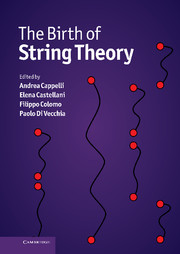Book contents
- Frontmatter
- Contents
- List of contributors
- Photographs of contributors
- Preface
- Abbreviations and acronyms
- Part I Overview
- EARLY STRING THEORY
- Part II The prehistory: the analytic S-matrix
- 5 Introduction to Part II
- 6 Particle theory in the Sixties: from current algebra to the Veneziano amplitude
- 7 The path to the Veneziano model
- 8 Two-component duality and strings
- 9 Note on the prehistory of string theory
- Part III The Dual Resonance Model
- Part IV The string
- TOWARDS MODERN STRING THEORY
- Part V Beyond the bosonic string
- Part VI The superstring
- Part VII Preparing the string renaissance
- Appendix A Theoretical tools of the Sixties
- Appendix B The Veneziano amplitude
- Appendix C From the string action to the Dual Resonance Model
- Appendix D World-sheet and target-space supersymmetry
- Appendix E The field theory limit
- Index
7 - The path to the Veneziano model
from Part II - The prehistory: the analytic S-matrix
Published online by Cambridge University Press: 05 May 2012
- Frontmatter
- Contents
- List of contributors
- Photographs of contributors
- Preface
- Abbreviations and acronyms
- Part I Overview
- EARLY STRING THEORY
- Part II The prehistory: the analytic S-matrix
- 5 Introduction to Part II
- 6 Particle theory in the Sixties: from current algebra to the Veneziano amplitude
- 7 The path to the Veneziano model
- 8 Two-component duality and strings
- 9 Note on the prehistory of string theory
- Part III The Dual Resonance Model
- Part IV The string
- TOWARDS MODERN STRING THEORY
- Part V Beyond the bosonic string
- Part VI The superstring
- Part VII Preparing the string renaissance
- Appendix A Theoretical tools of the Sixties
- Appendix B The Veneziano amplitude
- Appendix C From the string action to the Dual Resonance Model
- Appendix D World-sheet and target-space supersymmetry
- Appendix E The field theory limit
- Index
Summary
Abstract
Marco Ademollo, in his contribution to this Volume, has given a review of early work that led to string theory. I will complement this view of that period and its origin. My main purpose is to go further back in time and put the appearance of string theory work in the context of the evolution of the theory of elementary particles.
Introduction
Just after the end of the second world war, the resounding confirmation of relativistic field theory (more precisely, quantum electrodynamics) took place with Lamb's measurement of the level shifts in hydrogen and Schwinger's calculation of the electron magnetic moment, which differed from the value predicted from Dirac's equation. Renormalization theory with American, European, and Japanese contributions gave remarkable results with accuracies beyond one part in one hundred million.
All of these results were obtained using perturbation theory and though the agreement was remarkable, questions of principle on whether the series are convergent and divergences exist, requiring a modification of the theory, loomed in the discussions.
Soon after, with the discovery of mesons, and later other baryons, besides the proton and neutron, attention concentrated on the strong interactions. Pauli, Wentzel, Tamm, Dancoff, Dyson and others worked on the problem (for a short review, see Salpeter [Sal08]).
The natural thing to do was to write a Lagrangian for mesons and nucleons, and try all possible couplings in perturbation theory. It soon became clear that these calculations did not describe the experimental data.
- Type
- Chapter
- Information
- The Birth of String Theory , pp. 116 - 121Publisher: Cambridge University PressPrint publication year: 2012



